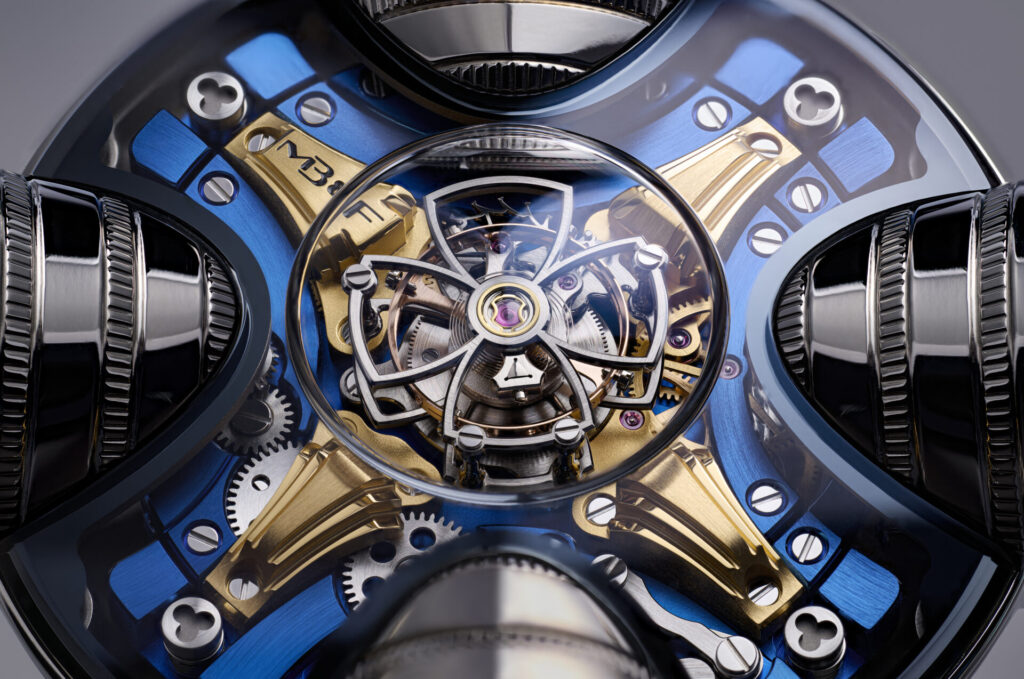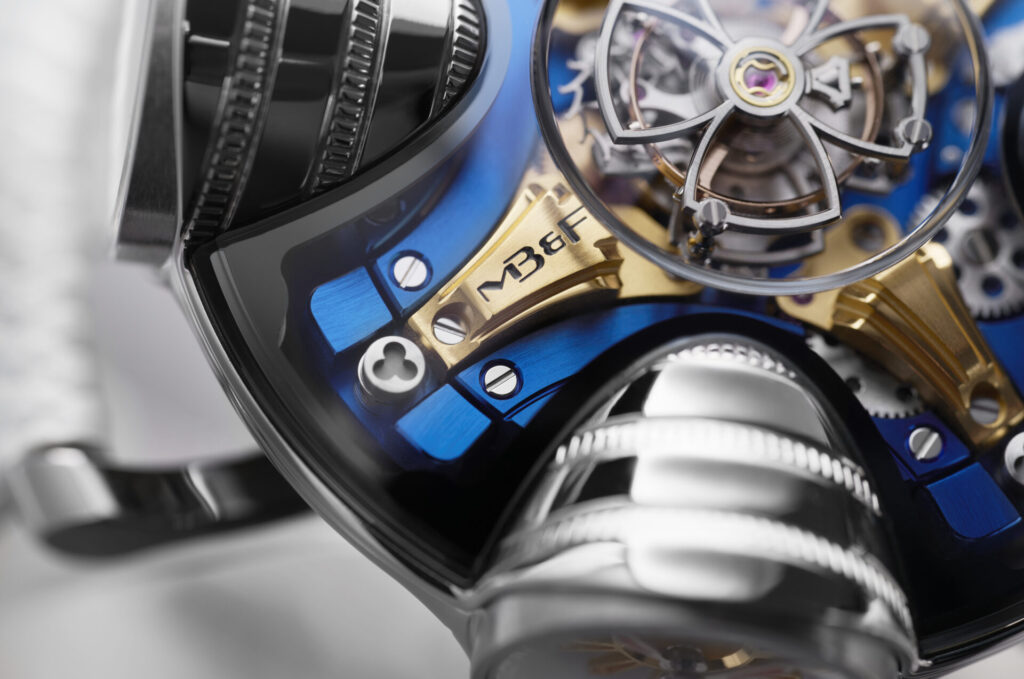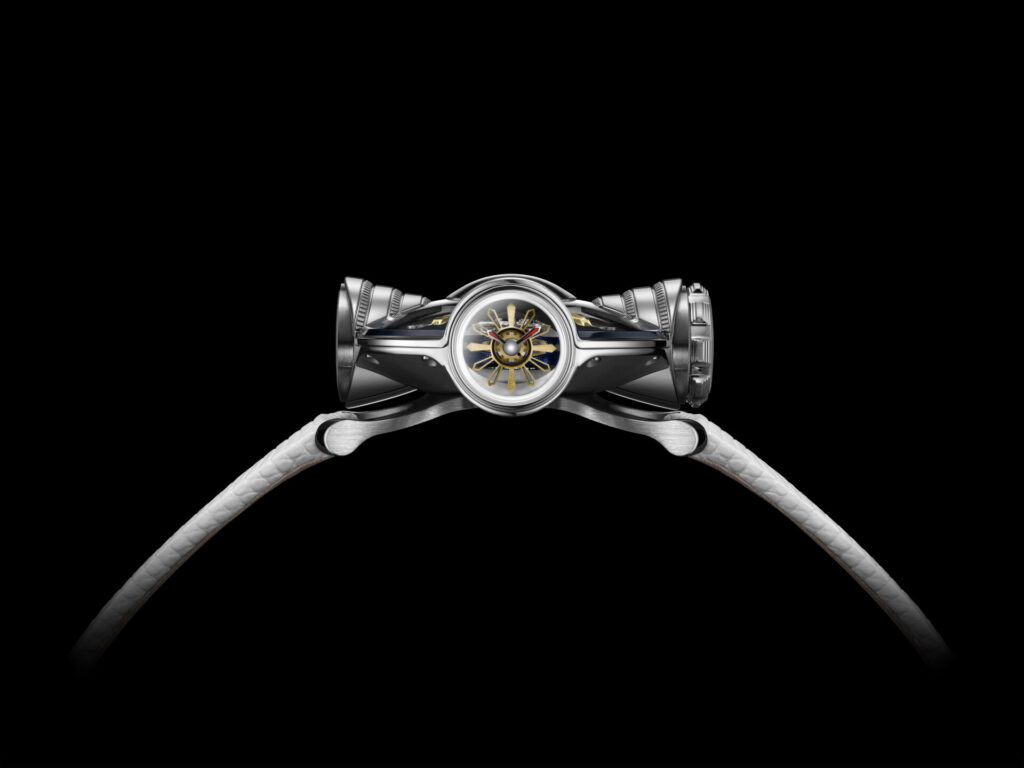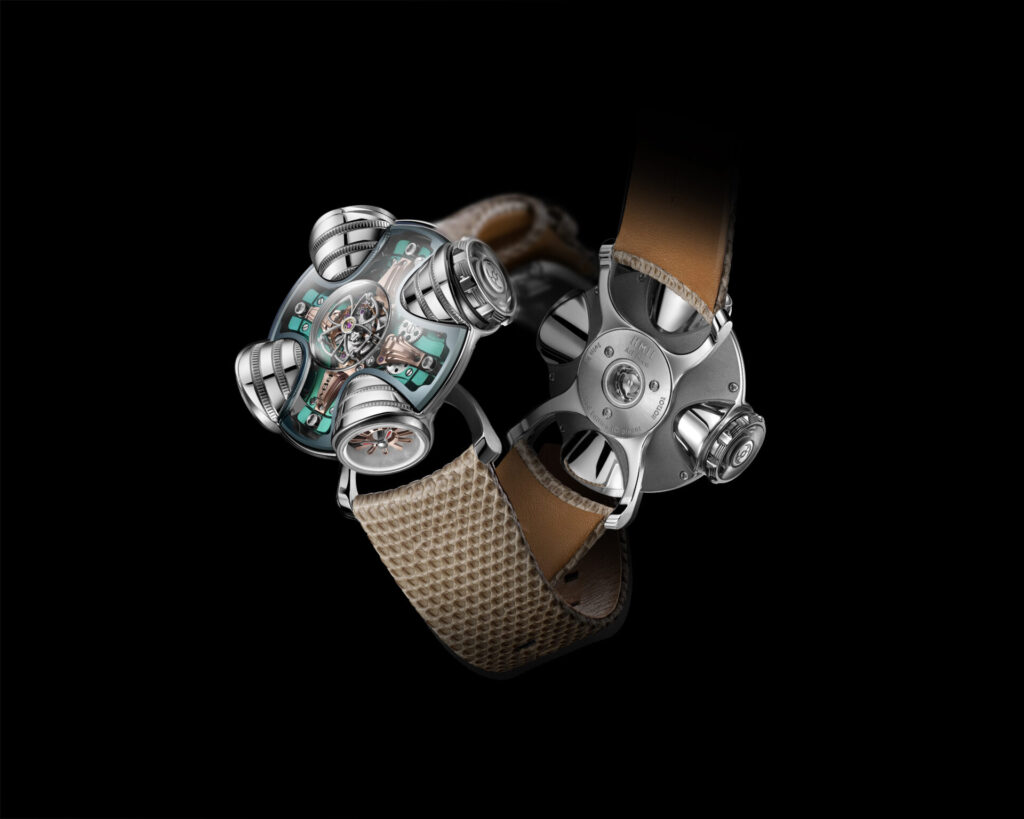The MB&F HM11 Art Deco looks like miniature architecture because that is precisely the intention. The first HM11 Architect, launched in 2023, drew from 1960s neo-futurism with smooth, rounded forms. The 2025 Art Deco edition keeps the same mechanical layout but shifts the entire visual language: sharper geometry, sunburst motifs, stepped surfaces and a profile that nods directly to Manhattan’s interwar towers.
It’s an unconventional concept that works thanks to the coherence of its execution. Most complex watches follow traditional case construction and allow the movement to take centre stage; MB&F reverses that logic. Here, the case becomes the main narrative, a 42mm titanium structure built around four functional chambers, each with a dedicated purpose. The appeal lies in how naturally these architectural elements integrate, despite looking unlike anything else in contemporary watchmaking.
Organic Curves to Art Deco Geometry
The layout becomes intuitive once you understand the framework. A flying tourbillon serves as the central volume, visible beneath a double-domed sapphire crystal. Four chambers extend from this core, each housing a different display or function. Hours and minutes appear via rod-mounted orbs in aluminium and titanium. The power reserve is shown through five graduated spheres. A mechanical thermometer covers a range from –20 to 60°C. The fourth chamber contains the time-setting module, a transparent mechanism that opens with a precise click.

A defining feature is the rotating case. It turns independently of the movement, allowing the wearer to bring any chamber forward or pivot by 45 degrees. This rotation is the winding system, with every 45-degree clockwise turn delivering 72 minutes of power and ten full rotations achieve the complete 96-hour reserve.

The engineering required to support this architecture is substantial. The sapphire crown alone spans nearly 10mm and uses eight gaskets to maintain water resistance while still allowing rotation. Including the case and bezel, the total reaches nineteen. The in-house manual calibre runs at 2.5Hz and supports the flying tourbillon via four laser-cut steel springs adapted from aerospace applications. The result is serious mechanical watchmaking presented through an architectural lens.
From Curves to Geometry
Designer Maximilian Maertens approached the Art Deco evolution with a reference point of the Rex cinema in Paris, a building that left an early impression on him. His task was to reinterpret the HM11 while preserving its identity, changing the aesthetic language without altering its mechanical structure.

The most visible updates sit on the dial side. The conical rods of the original give way to radiating sunburst patterns, laser-cut and partially open for clarity. Markers receive circular-grained surfaces with 3N yellow-gold PVD on the blue edition and 5N rose-gold PVD on the green. Two-tone rings separate displays, and the temperature scale adopts typography appropriate to the period.The hands introduce one of the edition’s standout details: a red translucent enamel, developed through numerous tests to achieve the right tone under both direct light and backlighting.

Other components adopt more vertical, structured forms. Bridges echo architectural stonework. Grooved “roof” elements reference stepped skyscraper profiles. The tourbillon bridge has been redrawn so that its axis aligns cleanly with the larger bridge architecture. Even the crown incorporates tiered detailing to match the overall geometry. Individually these adjustments are modest, but collectively they shift the watch’s character from softly organic to distinctly architectural.
A Refined Finish
The finishing work underscores the seriousness of the project. The dial frame originally caused complications; early prototypes used a solid ring that hindered orientation. The final solution involved laser-cut apertures with tolerances around 0.2mm, which is roughly two human hairs in width, requiring this step to be completed before final finishing. The frame then received diamond-cut details, micro-blasting and circular satin treatment.

The upper cage bridge incorporates multiple inward angles, all completed by hand by specialists capable of controlling the geometry cleanly. The four peripheral bridges alternate polished and satin surfaces to produce shifting light across the case. Sapphire components receive individual treatment, with each groove cut using a different tool and larger grooves finished by hand. Anthracite metallisation darkens the crystal edges to conceal gaskets and structural supports.
Despite the aesthetic overhaul, the fundamentals remain unchanged, with grade 5 titanium case, sapphire crystals on every surface with double-sided anti-reflective coating, 20-metre water resistance, manual movement with 96-hour reserve and winding via case rotation.
Two Limited Editions
The HM11 Art Deco is available in two variants, each limited to ten pieces. One combines a blue dial with 3N yellow-gold-toned bridges and a white lizard strap. The other pairs green with 5N rose-gold-toned bridges and a beige strap. Both use titanium folding clasps. Despite the watch’s dimensional complexity, the profile remains wearable, sitting at 42mm across and 23mm in height. Curved feet double as strap attachments, helping distribute weight and stabilise the case during winding. Titanium construction keeps the overall feel lighter than the architecture suggests.

Placed beside the original Architect, the contrast is immediate. The first edition reads as soft, experimental and influenced by the organic lines of late-modernist design. The Art Deco version is cleaner, more vertical, and more structured. The mechanical base is identical, but the visual impact is entirely different—two interpretations of the same architectural idea.
A Statement of Horological Innovation
The edition is deliberately limited to twenty pieces, ensuring its rarity. For collectors, this is a statement of technical ambition and design ingenuity. Every detail, from the enamel hands to the rotating-case winding system, demonstrates how MB&F continues to push the boundaries of contemporary horology while respecting the mechanical integrity of the original HM11 Architect.
The HM11 Art Deco embodies what MB&F does best: redefining expectations of what a wristwatch can be. It is precise, bold, and unapologetically distinctive. And with only twenty pieces worldwide, it is reserved for collectors who appreciate horology as both engineering and art.


